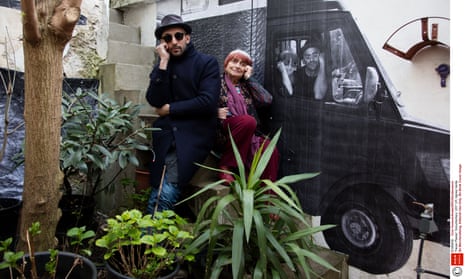There’s a wonderful warmth and playful indirectness to this essay/road movie in the classic nouvelle vague spirit, conjuring a semi-accidental narrative in the midst of what is ostensibly a documentary.
It is a collaboration between the 90-year-old director Agnès Varda and a 35-year-old French street artist who styles himself simply JR and always wears a hat and dark glasses, indoors and out – an opaque mannerism, almost a disguise, which Varda compares to her old comrade Jean-Luc Godard, and which irritates her a little bit.
Our odd but evenly-matched couple go on the road all over France in JR’s specially adapted van, which is like a mobile photo booth. They arrive in villages and towns and get locals to have their portrait pictures taken in the back of his vehicle, which he can then print out at gigantic size, sometimes doing a whole body shot printed out piecemeal, and which he then plasters on to the sides of buildings, matching the sections up with a wallpaperer’s skill, though we never see this tricky manoeuvre. The results are utterly spectacular, and often unbearably moving.
Varda and JR put giant pictures of early-20th-century miners on the side of cottages once occupied by these workers, with the huge face of one woman who is the only person still living in the terrace. She is overwhelmed with emotion to see it. You can feel what she feels.
This collaboration of Varda and JR is a bit like Steve Coogan and Rob Brydon in Michael Winterbottom’s The Trip, or maybe like Aretha Franklin duetting with George Michael. And the pictures themselves: what are they? For all their stunning force, they could be criticised as a novelty, or even a kind of vanity, tacitly contrasting the subjects’ humility with the artist’s immense prestige. Does JR envisage them being up for ever, or is ephemerality a part of their charm?
The duo put up a picture on an extraordinary concrete structure sticking up surreally in the midst of a vast beach: a wartime blockhouse that, in fact, fell from the edge of a cliff. The sea washed the image off within 24 hours, and I felt oddly glad, in a way, because the structure had its own beauty. But really the images are rather glorious.
Eventually, a sour note is struck by the old curmudgeon, Godard, himself. He is pointedly not at home when Varda and JR call, breaking what appears to have been a date, I suspect because he did not care to play a supporting role in Varda’s movie and also because he fought shy of being called an “older” version of Varda’s current collaborator. She is angry and upset, and she isn’t acting. It is a beguiling and unique piece of work.
